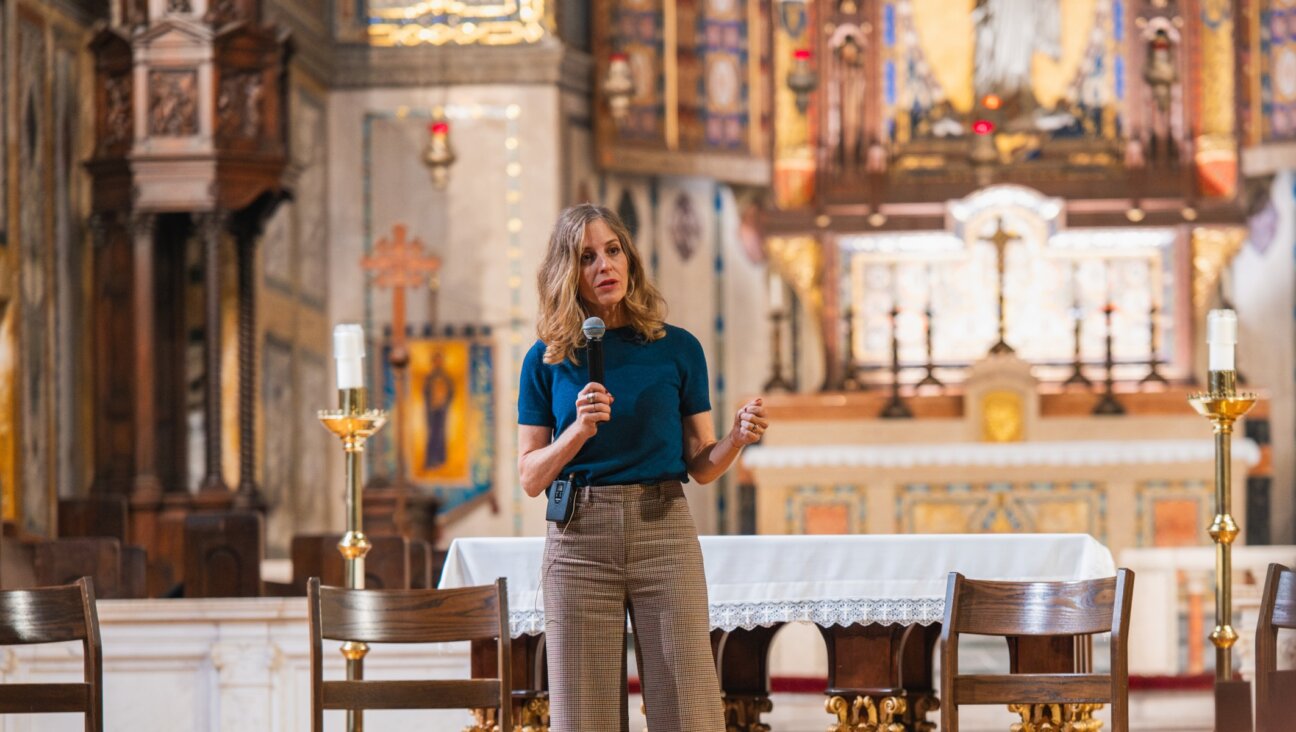Sproing! The Unexpected Sensuality of Welded Steel
Ann Sperry’s powerful, meditation-inducing sculptures on display at the retrospective at the Hebrew Union College-Jewish Institute of Religion Museum (through June 26) testify to a career defined by obsessions. How to register in hard steel the lambent instant when something springs into life. How to re-create, with an absence of sentimentality (and often by using recycled machine parts), the joy of extreme natural beauty and the mysteries of the flesh. But most of all, her work documents one artist’s prowess with the stark power of basic forms. Leaving her show, one feels thrilled both by the emotional and perhaps autobiographical force of her work and by the sheer pleasure of seeing those giant metal coils and cones.
The eerie pull of Sperry’s work is established by the first piece, “Rites of Passage IV,” showing two hinged metal discs the size of old LPs in which the silvery, disjointed limbs of a doll-child whirl and reach out with spooky, perfect hands into our space. One silvery child-head is caught in a look of wonder. Another’s legs push out from a primordial darkness into which it looks as if they may instantly be subsumed. The effect is jarring — the infant looks like a smiling robotic duplicate, with skin as shiny as a space-suit. Will the thing emerging into life be a real baby or an alien replica? Are we meant to take the charming expressions on the infants’ faces as true innocence or its mimicry? A nearby related work, called “Doorway to My Dreams,” consists of two shut, dark aluminum doors bristling with tiny child hands that stretch toward the viewer — yearning, frightening, a chunk of furniture becoming flesh, exacting a claim.
Much of Sperry’s work has the same pungent ambiguity — the subject matter is both happy-making and unnerving. One feels something like the awe one feels at a bris or in a hospital; here is the very seam of life, wholly physical and yet transcendent. Sperry seems intent on keeping her fingers on the place where the two realms join, where the immanent becomes palpable or seems about to plunge back into oblivion.
In the “Tender Flesh” series, Sperry created membrane-thin, egg-like shapes she then painted a rosy Caucasian-pink. “I wanted to get away from what the macho guys were doing with sculpture. Besides, welding steel is terribly sensuous,” she told the Forward, mischievously. “I wanted to bring that out. I love the very process of welding — the way the metal goes from red to orange to pink to white hot, which is when it liquefies and you can bend it like spaghetti.”
In “Vessel II” (1976), we look inside the bottom half of an egg-like sphere that has been penetrated by a flagellate, writhing, ribbony shape. In the accompanying “Vessel I” (1976), we gaze at the bottom of two scooped-out spheres linked by a similar tongue-like undulating ribbon. The spheres have the swollen delicacy and heft of emptied grapefruits; the connecting ribbon, painted the same pink as the spheres, seems like the very stuff-of-life run amok, extra life-stuff slithering between big and little spheres. “The first time I showed this work, three different men came up to me, angry,” Sperry said. “‘How can you paint such a strong material such a weak color?’ one asked. ‘That’s the color of hair ribbons!’ I was so excited to elicit rage from somebody looking at art.”
One of the most powerful pieces in the show is from the “Desires and Obsessions” series (1987) — a paneled cone apparently ripped open by a coiling hose-like tendril, as powerful as a strangler fig, that has thrust itself out of the cone’s interior. It is like the force of nature gone mad, ripping up industrialized civilization, tearing asunder a human being’s armored defenses. The piece is actually one of a series depicting the battle and rapprochement between vine and cone, Dionysian and Apollonian, or in the words of the artist: “men and women.”
Following in the tradition of David Smith, who was himself inspired by the welded constructions of Pablo Picasso and Julio Gonzalez, Sperry is an artist of the found object, favoring the recycled bits of farm implements — water-tank bottoms, disc harrows (from tractors) and cow-barn pipes. At the heart of the show is “The Creation: Seven Days,” a grouping of towering free-standing sculptures grouped in a circle. Each day of creation is represented by a delicate pillar, a column that corkscrews, often flinging itself upward in a manner that evokes the breathless, wildly hopeful surge of life itself. The sculptures erupt into blossom or drip back down to earth. Gigantic machinery parts that look like titanic drill-bits are welded to curving biomorphic forms, which spring from them in a manner reminiscent of Constantin Brancusi’s “Bird in Flight.” The work is exuberant, dangerous and commanding.
“I was once asked who my female role models are,” Sperry said. “I thought, ‘I don’t have any female role models. They all were men.’ But then I realized: my mother! She was a seamstress. We would go to Hester Street and buy remnants. Once she bought a box of little squares of beaver. The entire box cost 25 cents. She made me a coat with a big hood, stitching all those pieces together. I buy my own materials in scrap yards. But this is where [my inspiration] comes from.”
The last room includes Sperry’s most recent work, including pieces of the emotionally affecting “My Piano 7.” When Sperry was a child she craved having a real piano. Her father, a poor Yiddish poet who worked as a proofreader and editor at the Forward, bought her a piano for which he sacrificed to make payments for 10 years, long after Sperry had stopped playing it. Learning this only after her father’s death, Sperry was unable to part with the long-damaged instrument and dismantled it for use in three of her most intriguing sculptures here. Copper-coiled piano-wire wraps around a gold planet that resembles a heart. Bundles of piano pegs that look like bullets are bound to the surface of the gold object. Wedges of the piano legs cantilever out at disjointed angles, in the manner of Marcel Duchamp’s “Nude Descending a Staircase.” The red fabric-tipped hammers of the piano are soldered to the surface of the globe.
The work is both beautiful and revelatory, culminating a career that thrillingly investigates the way life’s mysteries — fertility, erotic passion, organic nature — are welded to the hard-edged, the mass-produced, the industrial material in which we all live.
Bonnie Friedman is the author, most recently, of “The Thief of Happiness: The Story of an Extraordinary Psychotherapy” (Beacon). She last appeared in these pages July 5 reviewing “Underneath the Lintel” at the SoHo Playhouse.
Silvery Coils and Cones Spring to Life in a Retrospective of the Work of Feminist Sculptor Ann Sperry
A message from our Publisher & CEO Rachel Fishman Feddersen

I hope you appreciated this article. Before you go, I’d like to ask you to please support the Forward’s award-winning, nonprofit journalism during this critical time.
We’ve set a goal to raise $260,000 by December 31. That’s an ambitious goal, but one that will give us the resources we need to invest in the high quality news, opinion, analysis and cultural coverage that isn’t available anywhere else.
If you feel inspired to make an impact, now is the time to give something back. Join us as a member at your most generous level.
— Rachel Fishman Feddersen, Publisher and CEO























